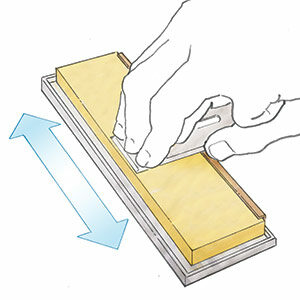
Synopsis: Sometimes the most basic and obvious principles escape our attention. A good example is microsharpening, a concept that can be used to advantage by every woodworker on most woodworking tools. The idea is to add a narrow microbevel in the final sharpening, thereby producing a more durable edge. In this quick article, wood technologist R. Bruce Hoadley explains how to do that without making the edge too fragile on a chisel, a plane, and a jackknife.
Sometimes the most basic and obvious principles escape our attention. A good example is microsharpening, a concept that can be used to advantage by every woodworker on a wide array of woodworking tools. The basic idea is simply to add a very narrow microbevel in the final sharpening, thereby producing a more durable edge.
When tools are sharpened, they are ground down to form a usually specified sharpness angle. The smaller the angle, the sharper the tool will be, but also the more fragile the edge and the quicker it will dull. Increasing this angle increases the durability of the edge but also increases the cutting force required to push the edge through the wood. The force may also be compounded by the clearance angle — the angle the bottom of the tool makes with the wood. With hand tools, the clearance angle can be virtually zero, but with power tools frictional heating requires a positive clearance angle. (With dull tools, the clearance angle actually becomes negative.)
So there is a trade-off involved — to decrease the cutting force required without decreasing the tool’s sharpness angle to the point of making the edge too fragile. Adding a microbevel gives us a compromise. It increases the effective sharpness angle of the tool, but doesn’t affect chip formation because the bevel is so narrow.
In carving chisels, as typified by the common gouge, a microbevel of about 0.005-inch on the concave face increases the effective sharpness angle to about 25-35 degrees (from 15 degrees) and will make a world of difference in longer edge wear. After the conventional sharpening is completed, the microbevel can be applied by light strokes of a round hard Arkansas pencil or round-edge slip on the concave face. This leaves the flatness of the clearance face undisturbed to ensure the edge will “bite” but modifies the sharpness angle. Determining the correct width of the microbevel may be aided at first by using a magnifying glass and hair for comparison. Eventually, the bright reflection of the microbevel can be gauged by eye, or the necessary number of strokes of the stone may become standardized.
The common bench-type hand plane can also be microsharpened to advantage. But to avoid interfering with chip formation, the microbevel should be added to the already ground bevel forming the under face. Keeping the microbevel to only about a 40-degree sharpness angle will ensure that a slight positive clearance angle still remains. This is the “honing angle” often recommended in plane sharpening.
With boring bits, microbevels can be added to the lips and to the inner edge of the spurs.
From Fine Woodworking #2
For the full article, download the PDF below:
Fine Woodworking Recommended Products

Mist Coolant System

Suizan Japanese Pull Saw

Tite-Mark Marking Gauge





















Log in or create an account to post a comment.
Sign up Log in